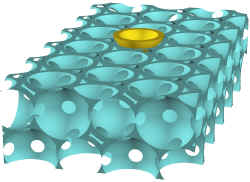Circuits of Light

Microchip designers dream of integrated circuits that run on light. Photons, rather than electrons, would relay signals among millions of transistors, switches, and perhaps microlasers. Photons are faster and more efficient than electrons, and they can even pass through one another. In the 2 August PRL a University of Toronto team takes a step toward this goal by giving a recipe for a material whose light transmission can be programmed micron-by-micron in three dimensions, and whose “light circuits” could even be rerouted after fabrication as conditions change.
For more than a decade physicists have been working toward photonic band gap (PBG) materials–crystalline structures that exclude light transmission in all directions for specific wavelength ranges, just as semiconductors exclude electron propagation for certain energy bands. With such a material researchers could make microscopic “wires” and perhaps switches and transistors operating entirely with light. Three-dimensional PBG materials for visible light have been successfully fabricated only within the past year or two, but Kurt Busch and Sajeev John of the University of Toronto are already thinking about the next step–a tunable band gap material, where the gap could be opened or closed at will.
Busch and John are developing a PBG material they call inverse opal which is 75% air by volume. They studied the effects of coating its internal surfaces with a liquid crystal, whose light transmission properties are easily controlled by applying an electric field. According to their calculations, the range of forbidden wavelengths at a specific location in the structure can be adjusted by the local electric field, or the band gap can be eliminated altogether.
John envisions an “integrated optical circuit,” where a slab of the material is surrounded by a mesh of wires, each of which can produce a localized electric field, just as laptop computer displays have a wire addressing each dot on the screen. The wires would not only configure the microlasers, switches, and optical “wires” of an optical circuit, John explains, but the circuit could be changed at any time, perhaps even “learning” which configuration is optimal for a given situation.
Attila Mekis of the Massachusetts Institute of Technology calls the results “very exciting” because the paper describes a tunable PBG material that can be fabricated. “It’s not just a general theoretical argument,” he says, “but a practical application.” The telecommunications industry is most interested in this technology, according to Mekis, because fiber optic lines could be naturally interfaced with all-optical circuits, rather than including conventional electronics in the system, and because photons provide higher bandwidth than electrons.


